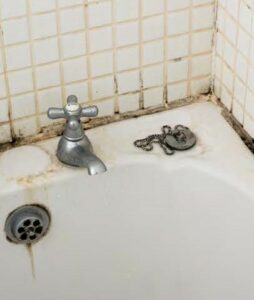Mould, damp and the lungs
This page will talk about the impact of mould and damp on lung health – and what can be done to protect your lungs.
Back to: Indoor air pollution and the lungs
What is mould and damp?
Mould is a type of fungus that grows in damp areas. It releases tiny particles called spores that can be harmful when breathed in. Mould and damp are found in buildings where there is excess moisture, poor ventilation and/or lack of sunlight. This could be caused by any of the following:
- Leaking pipes, roofs or window frames
- Rising damp – where water from the ground is absorbed into the walls in basements or ground-level rooms
- Condensation – where humid air (air containing high levels of water vapour) comes into contact with cold surfaces indoors and collects as drops of water
- Water used as part of building work (for example, in plaster) that has not fully dried out yet
- Day-to-day activities, such as cooking, showering or drying clothes, in buildings with poor ventilation.
Is spending lots of time in damp indoor environments bad for lung health?
Research has shown that living, working or going to school in a damp indoor environment can cause a number of problems. These could include:
- Asthma – flare-ups for people that already have the condition and possibly the onset of asthma
- Cough
- Wheeze
- Catching colds or the flu
- Catching chest infections that are caused by breathing in tiny pieces of moulds (e.g. breathing in a type of mould called Aspergillus can cause an infection called aspergillosis)
- Being short of breath or finding it hard to breathe
- Rhinitis – swelling of the lining of the nose, causing sneezing and a runny or blocked nose
- Hypersensitivity pneumonitis – when the tissue in your lungs has an allergic reaction to a substance you breathe in and becomes inflamed (swollen). It is, however, quite rare to get this condition because of a damp indoor environment.
- House dust mites also thrive in warm, damp environments, and can cause allergic reactions (e.g. asthma symptoms, eczema and rhinitis)
People with lung conditions, babies and children, older people and those with weaker immune systems are more at risk. It is not clear what it is exactly in the damp and mould that causes lung health problems – but there are steps you can take that have been proven to reduce symptoms and protect lung health.
“When I react to mould, I firstly move away from the source. Then I take a significant dose of a steroid and my inhaler to help with my breathlessness.” Nona, Italy#

How do I know if there is a problem in my building?
If you are worried that there may be a problem with mould and damp in your home, workplace or school, look out for the following:
- Age of building – damaged, older buildings may be more likely to have problems with damp due to issues like rising damp or leaks. On the other hand, new buildings may also have damp due to condensation, or if the water used during building is still drying out.
- Wet basement – this could be a sign of rising damp.
- Water damage – due to leaks.
- Visual signs or smells of mould and damp.
What can I do to protect my lungs?
Getting rid of the damp and mould
Get rid of the mould and damp. You may be able to do this yourself, or you may need help from a professional.
1. Damp
The building may need repair work to make sure there are no water leaks causing problems with dampness.
Heating and ventilation are both very important. Make sure that the building is well-ventilated – either by regularly opening windows, or by using a fan ventilation system. When showering, bathing or cooking, open a window, use an extractor fan and close the bathroom or kitchen door. A dehumidifier may also help to reduce the amount of water vapour in the air. You should also avoid drying clothes by hanging them up indoors, as this adds moisture to the air. Use a tumble dryer or hang up laundry to dry outdoors instead. If drying your clothes indoors is your only option, use a dehumidifier in the room.
Keep the building at a suitable temperature. The World Health Organization recommends between 16–20°C in bedrooms, and between 19–22°C in the rest of the house. When away from the building, keep the temperature above 15°C.
2. Mould
Once damp has been dealt with, it is time to remove mould. Fabrics close to the source of mould (e.g. clothes, curtains, carpets, bedding, mattresses and toys) could be contaminated. All affected items will need to be disinfected or, preferably, replaced.
When mould is being cleared away, it will release tiny pieces of mould called spores into the air. Therefore, you should seal off the affected room by closing any doors to stop the spores from spreading into other rooms. Open the windows while clearing the mould and keep them open for a while afterwards. Once you have finished clearing up the mould, thoroughly clean all surfaces in the room to remove any spores.
“I would recommend that you avoid mould and try to get around damp. Maybe even consider moving somewhere else to another climate, but I know it is difficult to leave ones local social network and family. One could consider using an air purifier, but be careful to choose a system that is not a mould breeder.”
Ralf, Germany
If you do not own the building
Living, working or studying in a building that is affecting your health can be frustrating – especially if you are not directly responsible for maintenance. You should speak to your landlord, housing association or building manager, employer or the school administration about the issue so that they can take appropriate steps to solve the problem. In each case, these people have a duty of care to you.
Get medical help
If you notice that you have symptoms that are better when you are away from the place that is damp and mouldy, you should tell your healthcare professional so that they can consider whether this is a factor. Your healthcare professional will most likely recommend that you take steps to reduce your exposure to the damp and mould. They may also be able to give you medication to help relieve your symptoms, however these are not expected to solve the underlying cause (damp and/or mould).
“Get the affected areas renovated; every part of the building with mould on needs to go. And you should ventilate/air out as much as you can.” Liss, Norway





